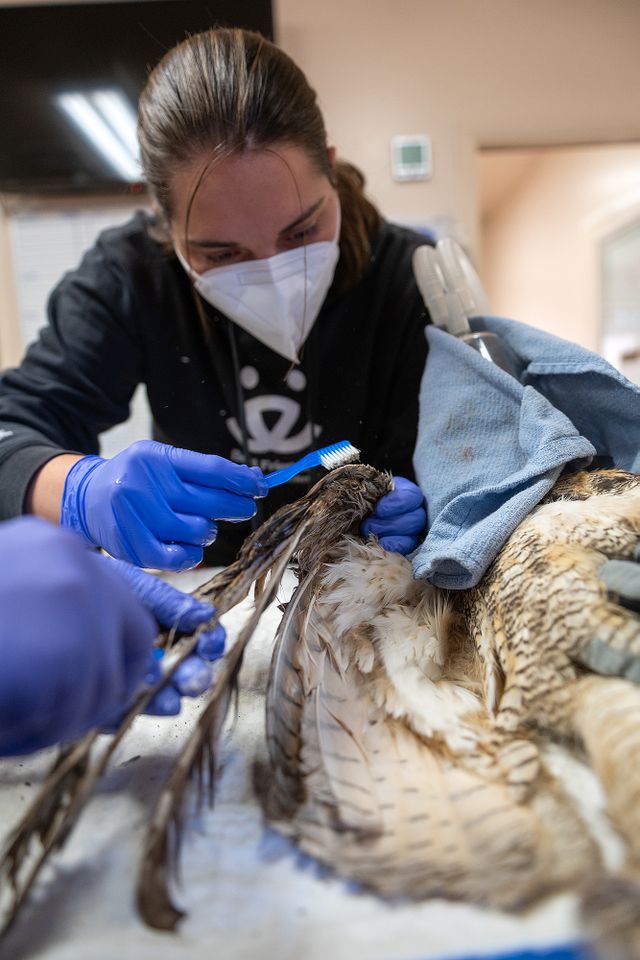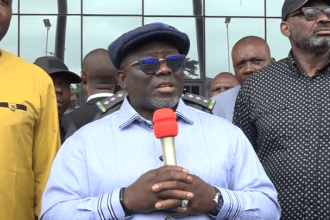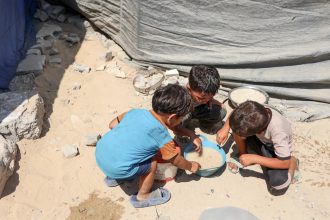NEED TO KNOW
-
A wild great-horned owl was rescued after being found covered in hardened concrete from a cement mixer
-
The animal received multiple warm water baths under anesthesia to remove the concrete
-
Best Friends Animal Sanctuary aims to release the bird into the wild next spring or summer after the owl molts
Rescuers at Best Friends Animal Sanctuary in Kanab, Utah, are familiar with unusual cases, but nothing prepared them for a great horned owl covered in hardened concrete.
The juvenile owl, weighing just two pounds, had somehow fallen into a cement mixer earlier this month, before being spotted by locals and brought to Best Friends’ Wild Friends rehabilitation center.
When staff conducted the bird’s first exam, they realized the extent of the problem: roughly a quarter of the owl’s body was encased in dried concrete.
A great-horned owl has concrete removed from its feathers at Best Friends Animal Sanctuary
“It was the first time Best Friends’ staff had seen a case like this in its 40-year history,” said Bart Richwalski, Wild Friends supervisor. After reaching out to other wildlife rehabilitators, Richwalski and his team discovered that no one else had encountered anything like it.
“We reached out to other wildlife rehabilitators and they had never heard of an owl falling into concrete before, either,” he revealed. “After doing some research, our team quickly came up with a plan to help the owl in the least invasive way possible.”
Never miss a story — sign up for PEOPLE’s free daily newsletter to stay up-to-date on the best of what PEOPLE has to offer, from celebrity news to compelling human interest stories.
The plan required patience and a lot of warm water. For six days, the rescue’s staff gave the owl a daily 20-minute bath under anesthesia, slowly softening and removing the concrete from the animal’s face, chest, and right wing.

A great-horned owl has concrete removed from its feathers at Best Friends Animal Sanctuary
To everyone’s relief, the bird began responding well. “This was a brand-new situation for the Wild Friends team, and they really stepped up to the plate to do their best for this owl,” said Judah Battista, Best Friends Animal Society’s chief sanctuary officer.
Richwalski shared that the owl — believed to be a young male born in 2025 — is now firmly on the road to recovery and has endured the most grueling part of his treatment.
“He still has a long road ahead of him, but he’s a fighter,” Richwalski added.
After careful consideration, the owl has been moved from his indoor soft-sided carrier to an outdoor enclosure, where staff recently watched him fly up to a six-foot perch — a promising sign his strength is returning. But the sanctuary says the owl will need to stay at the rescue until the spring or summer of 2026, after his next molt. After the owl’s molt, Best Friends Plans to release the bird in a forested area close to where it was initially found.

A great-horned owl has concrete removed from his feathers at Best Friends Animal Sanctuary
The owl is one of roughly 1,600 animals — from dogs and cats to horses, pigs, and other wildlife — currently receiving care at Best Friends Animal Sanctuary, the U.S.’s largest no-kill sanctuary and headquarters of Best Friends Animal Society. The organization partners with thousands of shelters and rescues across the country, sharing the goal of helping every animal in need find safety, healing, and a second chance.
Read the original article on People









